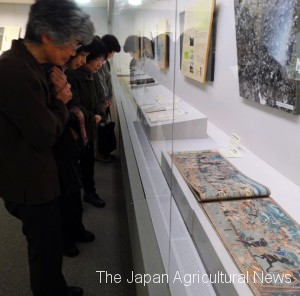Protect villagers’ lives by joining of the all households
Senzokabukumiai, which was credit cooperatives, began new business which was revolutionary during feudal age. All the villagers of Nagabe village (Asahi-shi, Chiba prefecture) joined to create a consumer association, and it began a joint purchase business.
Purchased goods included items necessary for agriculture such as agricultural tools, fertilizers and seeds, and daily necessities such as foods, sardines, udon(noodle), tea, clothes such as cotton, cloths, dishes, tables, tea bowls, combs, ornament hairpin.
Not only to buy good things cheaply. There was a philosophy policy of “not using luxuries”. It can also be viewed as a prototype of modern comprehensive nogyokyodokumiai (agricultural cooperatives) that combines credit and purchasing.
” The Rochdale Society of Equitable Pioneers “, established the UK in 1814, is said the world’s first cooperative. However, senzokabukumiai of Yugaku was established six years earlier than it was, in 1838 (Tenpo 9). Teru Takakura, writer (1891 to 1986), who wrote many novels and biographies of Yugaku, argued that “Senzokabukumiai is just the first established (cooperatives) in the world”.
In the association, “co-work” to cooperate with everyone had been routinely performed. According to Haruki Koshikawa’s “Yugaku Ohara research”, during the agricultural off-season or at night, men made ropes and women spun yarn, encouraged by Yugaku. Yugaku gathered young men and women and opened the rope making meetings once or twice per month, and sell the products so as to make the income of village and association. During the agricultural season, he also established paddy fields to co-cultivate. The paddy fields also served the role of the agricultural testing ground.
Pour power on education of women and children

Visitors watching Nishikie (brocade picture), which was used to tell stories to children (provided by Ohara Yugaku Museum)
On the other hand, among the men workers, there were people who could not manage their lives in agriculture and threw themselves into migrant workers. Lots of people fell into prodigal such as buy-hit-drink (the gambling), wasting money obtained in the migrant works. As it is known by “Tenpo Suikoden”, the movie depicting the conflict of the professional gamblers around the Tone River, people’s moral was disturbed. Yugaku set “Goyaku (Township)”, the village’s law, at that time.
Worrying about the its impact on the family and children, Yugaku focused on the education of women and children. According to Eriko Ino, curator of the Ohara Yugaku Museum, Yugaku provided the woman meetings and the children meetings, the days of the lecture for them, even in the tendency that education to women was unnecessary. There was also a biography that wrote the lives of women. “Yugaku Ohara and its surrounding”, edited by Motoi Kimura, introduces such situation.
Yugaku told stories to children by using Nishikie (brocade picture). Faded color brocade picture books remain a lot at the Museum. He opened the child competition, including sometimes competition of making ropes by organizing the group.
“Education of Kanshi (Exchange of children)” was also the innovative attempt. It was the long-term homestay that 7 to 16-year-old children of Doyu were mutually deposited in several houses for 1 to 2 years, in the principle that the child of poor house should be deposited to wealthy house and the child of wealthy house should be deposited to poor house. It was a fresh and exciting experience for children and it seemed that such attempt was well received by parents, and continued in this area until the Meiji period.
Mr. Ino, curator of the Museum, said, “Maybe Yugaku, who thought that the village’s foundation was ‘home’, focused on human resources development of women and children who would lead the future.”
“ Goyaku (Township, Law of the village)” established by Yugaku Ohara
・With regard to intersecting people, do with faith, respect the chief, love the young, and conduct in the process of equality
・Do not neglect your family business, do not arrogant things, leave the luxury such as haori (coat), kimono (clothes), tenugui (towel). Become like the ordinary villager and never deceive yourself
・Understand that evil people from the village shall make village shamed. Monitor each other and respect mutually
・As regards catching water for rice field, people used to be selfish. Therefore, make the mind to be quiet, consider very much, and do not fall into seeking one’s own interests.
・Also do the everything based on Deliberation of the whole village. Never do selfish behavior.
Seiichi Sugaya: “The current village of senzokabukumiai, Nagabe district, Hikatacho, Chiba Prefecture”, Foundation Nihon Nogyo Kenkyusyo (Japan Agricultural Research Institute)
【Booklet】Beginning of Cooperatives <Yugaku Ohara ③> Agrarian reform (April 25, 2015)

